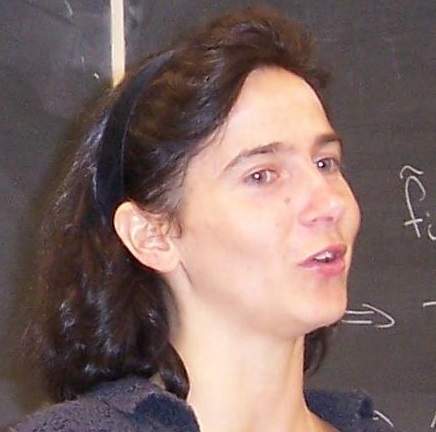11.E: Exercises for Chapter 11
- Page ID
- 312
Calculational Exercises
1. Consider \( \mathbb{R}^3 \)with two orthonormal bases: the canonical basis \( e = (e_1 , e_2 , e_3) \) and the basis \(f = (f_1 , f_2 , f_3) \), where
\[ f1 = \frac{1}{\sqrt{3}}(1,1,1), f_2 = \frac{1}{\sqrt{6}}(1,-2,1), f_3 = \frac{1}{\sqrt{2}}(1,0,-1). \]
Find the canonical matrix, A, of the linear map \(T \in \cal{L}(\mathbb{R}^3) \) with eigenvectors \(f_1 , f_2 , f_3 \) and eigenvalues 1, 1/2, −1/2, respectively.
2. For each of the following matrices, verify that \(A\) is Hermitian by showing that \(A = A^*\) ,find a unitary matrix \(U\) such that \(U^{−1}AU\) is a diagonal matrix, and compute \(exp(A)\).
\[ (a)~ A = \left[ \begin{array}{cc} 4 & 1-i \\ 1+i & 5 \end{array} \right] ~~ (b)~A = \left[ \begin{array}{cc} 3 & -i \\ i & 3 \end{array} \right] ~~ (c)~A = \left[ \begin{array}{cc} 6 & 2+2i \\ 2-2i & 4 \end{array} \right]\]
\[ (d)~A = \left[ \begin{array}{cc} 0 & 3+i \\ 3-i & -3 \end{array} \right] ~~ (e)~ A = \left[ \begin{array}{ccc} 5 & 0 & 0 \\ 0 & -1 & -1+i \\ 0 & -1-i & 0 \end{array} \right] ~~ (f)~ A = \left[ \begin{array}{ccc} 2 & \frac{i}{\sqrt{2}} & \frac{-i}{\sqrt{2}} \\ \frac{-i}{\sqrt{2}} & 2 & 0 \\ \frac{i}{\sqrt{2}} & 0 & 2 \end{array} \right] \]
3. For each of the following matrices, either find a matrix \(P\) (not necessarily unitary) such that \(P^{−1}AP\) is a diagonal matrix, or show why no such matrix exists.
\[ (a)~ A = \left[ \begin{array}{ccc} 19 & -9 & -6 \\ 25 & -11 & -9 \\ 17 & -9 & -4 \end{array} \right] ~~ (b)~A = \left[ \begin{array}{ccc} -1 & 4 & -2 \\ -3 & 4 & 0 \\ -3 & 1 & 3 \end{array} \right] ~~ (c)~A = \left[ \begin{array}{ccc} 5 & 0 & 0 \\ 1 & 5 & 0 \\ 0 & 1 & 5 \end{array} \right]\]
\[ (d)~ A = \left[ \begin{array}{ccc} 0 & 0 & 0 \\ 0 & 0 & 0 \\ 3 & 0 & 1 \end{array} \right] ~~ (e)~A = \left[ \begin{array}{ccc} -i & 1 & 1 \\ -i & 1 & 1 \\ -i & 1 & 1 \end{array} \right] ~~ (f)~A = \left[ \begin{array}{ccc} 0 & 0 & i \\ 4 & 0 & i \\ 0 & 0 & i \end{array} \right]\]
4. Let \(r \in \mathbb{R}\) and let \(T \in \cal{L}(\mathbb{C}^2)\) be the linear map with canonical matrix
\[ T = \left( \begin{array}{cc} 1 & -1 \\ -1 & r \end{array} \right) \]
(a) Find the eigenvalues of \(T\) .
(b) Find an orthonormal basis of \( \mathbb{C}^2\) consisting of eigenvectors of \(T\) .
(c) Find a unitary matrix \(U\) such that \(UT U^*\) is diagonal.
5. Let \(A\) be the complex matrix given by:
\[ A = \left[ \begin{array}{ccc} 5 & 0 & 0 \\ 0 & -1 & -1+i \\ 0 & -1-i & 0 \end{array} \right]\]
(a) Find the eigenvalues of \(A\).
(b) Find an orthonormal basis of eigenvectors of \(A\).
(c) Calculate \(|A| = \sqrt{A^*A}\).
(d) Calculate \(e^A\) .
6. Let \(θ \in \mathbb{R}\), and let \(T \in \cal{L}(\mathbb{C}^2) \)have canonical matrix
\[ M(T ) = \left( \begin{array}{cc} 1 & e^{i\theta} \\ e^{-i\theta} & -1 \end{array} \right). \]
(a) Find the eigenvalues of \(T\) .
(b) Find an orthonormal basis for \(\mathbb{C}^2\) that consists of eigenvectors for \(T\) .
Proof-Writing Exercises
1. Prove or give a counterexample: The product of any two self-adjoint operators on a finite-dimensional vector space is self-adjoint.
2. Prove or give a counterexample: Every unitary matrix is invertible.
3. Let \(V\) be a finite-dimensional vector space over \( \mathbb{F}\), and suppose that \(T \in \cal{L}(V)\) satisfies \(T^2 = T\) . Prove that \(T\) is an orthogonal projection if and only if \(T\) is self-adjoint.
4. Let \(V\) be a finite-dimensional inner product space over \( \mathbb{C}\), and suppose that \(T \in \cal{L}(V)\) has the property that \(T^* = −T \). (We call T a skew Hermitian operator on \(V\).)
(a) Prove that the operator \(iT \in \cal{L}(V)\) defined by \((iT )(v) = i(T (v))\), for each \(v \in V\) , is Hermitian.
(b) Prove that the canonical matrix for \(T\) can be unitarily diagonalized.
(c) Prove that \(T\) has purely imaginary eigenvalues.
5. Let \(V\) be a finite-dimensional vector space over \(\mathbb{F}\), and suppose that \(S, T \in \cal{L}(V)\) are positive operators on \(V\) . Prove that \(S + T\) is also a positive operator on \(T\) .
6. Let \(V\) be a finite-dimensional vector space over \(\mathbb{F}\), and let \(T \in \cal{L}(V)\)be any operator on \(V\) . Prove that \(T\) is invertible if and only if 0 is not a singular value of \(T\) .
Contributors
- Isaiah Lankham, Mathematics Department at UC Davis
- Bruno Nachtergaele, Mathematics Department at UC Davis
- Anne Schilling, Mathematics Department at UC Davis
Both hardbound and softbound versions of this textbook are available online at WorldScientific.com.


